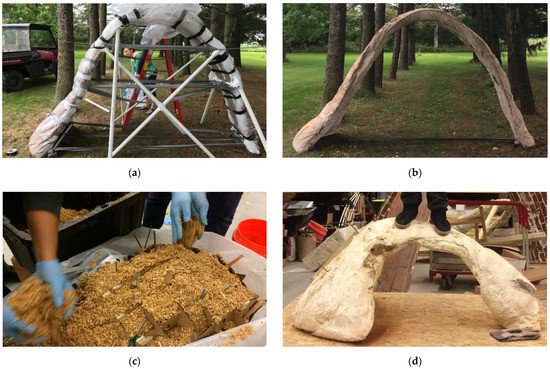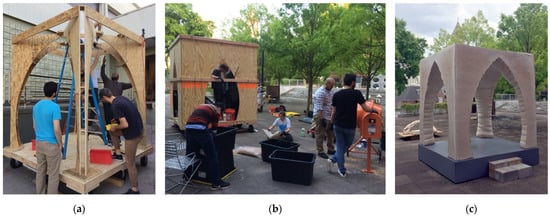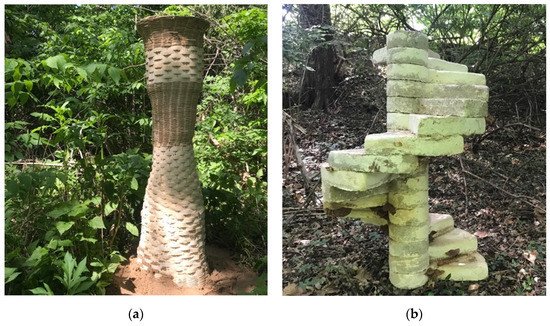
| Version | Summary | Created by | Modification | Content Size | Created at | Operation |
|---|---|---|---|---|---|---|
| 1 | Jonathan Dessi-Olive | -- | 3128 | 2022-09-26 15:50:16 | | | |
| 2 | Beatrix Zheng | -1 word(s) | 3127 | 2022-09-27 05:23:29 | | | | |
| 3 | Beatrix Zheng | + 6 word(s) | 3133 | 2022-09-28 08:42:59 | | | | |
| 4 | Beatrix Zheng | Meta information modification | 3133 | 2022-09-28 08:43:29 | | |
Video Upload Options
Within Euro-centric traditions of architecture, the significance of a building is often tied to its permanence. The Pantheon in Rome, for example, is a nearly 2000-year-old cementitious dome structure, whose resilience to time elevates it to a monumental status. Notwithstanding the significance of cultural and economic factors associated with the need for permanent buildings and structures, there is a doubt on whether all buildings should be assembled with the goal of being permanent. Globally, the lifespans of buildings are rapidly decreasing. The average lifespan of buildings in China was reported to be 34 years, and 25 years for residential buildings in Japan. To great detriment, buildings are more than ever being demolished prematurely and yet, use materials that are manufactured with energy-intensive processes and are expensive or impractical to recycle. In the United States alone, the Environmental Protection Agency (EPA) reported there was 600 million tons of construction and demolition waste generated in 2018. Structural materials, including wood, and architectural metals, such as steel, copper, and brass, are valuable commodities that can be reused and recycled. However, in present-day architectural assemblies, these materials nearly ubiquitously inter-face with expanded foams, plastics, and resins, sometimes in irreversible composites. For example, wood is widely treated with synthetic resins and glues to increase its resistance to decay or structural performance.
1. Introduction
2. Mycelium Composite Materials
3. Brick and Block Myco-Structures
4. Monolithic and Bio-Welded Myco-Structures
4.1. Monolithic Myco-Structures




4.2. Bio-Welded Myco-Structures
References
- Liu, G.; Xu, K.; Chang, X.; Chang, G. Factors influencing the service lifespan of buildings: An improved hedonic model. Habitat Int. 2014, 43, 274–282.
- Wuyts, W.; Miatto, A.; Sedlitzky, R.; Tanikawa, H. Extending or ending the life of residential buildings in Japan: A social circular economy approach to the problem of short-lived constructions. J. Clean. Prod. 2019, 231, 660–670.
- Environmental Protection Agency. Sustainable Management of Construction and Demolition Waste. 2018. Available online: https://www.epa.gov/smm/sustainable-management-construction-and-demolition-materials (accessed on 15 June 2022).
- Trubiano, F.; Onbargi, C.; Finaldi, A.; Whitlock, Z. Fossil Fuels, The Building Industry, and Human Health; Kleinman Center for Energy Policy: Philadelphia, PA, USA, 2019; Available online: https://kleinmanenergy.upenn.edu/research/publications/fossil-fuels-the-building-industry-and-human-health-evaluating-toxicity-in-architectural-plastics/ (accessed on 21 August 2022).
- National Institute of Environmental Health Science. Endocrine Disruptors; National Institutes of Health: Washington, DC, USA, 2010. Available online: https://www.niehs.nih.gov/health/materials/endocrine_disruptors_508.pdf (accessed on 21 August 2022).
- Stichnothe, H.; Azapagic, A. Life cycle assessment of recycling PVC window frames. Resour. Conserv. Recycl. 2013, 71, 40–47.
- Marten, B.; Hicks, A. Expanded Polystyrene Life Cycle Analysis Literature Review: An Analysis for Different Disposal Scenarios. Sustainability 2018, 11, 29–35.
- Environmental Protection Agency. Municipal Solid Waste Generation, Recycling, and Disposal in the United States. 2014. Available online: https://www.epa.gov/sites/default/files/2015-09/documents/2012_msw_dat_tbls.pdf (accessed on 21 August 2022).
- Gray, A. Germany Recycles More Than Any Other Country. World Economic Forum. 2017. Available online: https://www.weforum.org/agenda/2017/12/germany-recycles-more-than-any-other-country/ (accessed on 21 August 2022).
- Geyer, R.; Jambeck, J.; Law, K.L. Production, use, and fate of all plastics ever made. Sci. Adv. 2017, 3, e1700782.
- McDaniel, V. How the Pandemic Drove up The Cost of Wood Products. U.S. Department of Agriculture. 13 May 2022. Available online: https://www.fs.usda.gov/features/how-pandemic-drove-cost-wood-products (accessed on 21 August 2022).
- Stamets, P. Mycelium Running: How Mushrooms Can Help Save the World; 10 Speed Press: Berkeley, CA, USA, 2005.
- Ecovative Design. Available online: https://ecovativedesign.com/ (accessed on 15 June 2022).
- Mycoworks. Available online: https://www.mycoworks.com/ (accessed on 15 June 2022).
- Mogu.bio. Available online: https://mogu.bio/ (accessed on 15 June 2022).
- Holt, G.A.; McIntyre, G.; Flagg, D.; Bayer, E.; Wanjura, J.D.; Pelletier, M.G. Fungal Mycelium and Cotton Plant Materials in the Manufacture of Biodegradable Molded Packaging Material: Evaluation Study of Select Blends of Cotton Byproducts. J. Biobased Mater. Bioenergy 2012, 6, 431–439.
- Mushroom Packaging. Available online: https://mushroompackaging.com/ (accessed on 15 June 2022).
- Magical Mushroom Company. Available online: https://magicalmushroom.com/ (accessed on 15 June 2022).
- Grown.Bio. Available online: https://www.grown.bio/shop/ (accessed on 15 June 2022).
- Forager. Available online: https://forager.bio/ (accessed on 15 June 2022).
- Bolt Threads. Available online: https://boltthreads.com/ (accessed on 15 June 2022).
- Gandia, A.; van den Brandhoff, J.G.; Appels, F.V.W.; Jones, M.P. Flexible Fungal Materials: Shaping the Future. Trends Biotechnol. 2021, 39, 1321–1331.
- Bayer, E.; McIntyre, G. Method for Producing Grown Materials and Products Made Thereby. U.S. Patent 9485917B2, 8 November 2016. Available online: https://patents.google.com/patent/US9485917B2/en?oq=US9485917 (accessed on 15 June 2022).
- Elsacker, E.; Vandelook, S.; Brancart, J.; Peeters, E.; De Laet, L. Mechanical, physical, and chemical characterization of mycelium-based composites with different types of lignocellulosic substrates. PLoS ONE 2019, 14, e0213954.
- Jones, M.; Mautner, A.; Luenco, S.; Bismark, A.; John, S. Engineered mycelium composite construction materials from fungal biorefineries: A critical review. Mater. Des. 2020, 187, 108397.
- Girometta, C.; Picco, A.M.; Baiguera, R.M.; Dondi, D.; Babbini, S.; Cartabia, M.; Pellegrini, M.; Savino, E. Physico-Mechanical and Thermodynamic Properties of Mycelium-Based Bio-composites: A Review. Sustainability 2019, 11, 281.
- Appels, F.V.W.; Camere, S.; Montaliti, M.; Karana, E.; Jansen, K.M.B.; Dijksterhuis, J.; Krijgsheld, P.; Wösten, H.A.B. Fabrication factors influencing mechanical, moisture- and water-related properties of mycelium-based composites. Mater. Des. 2019, 161, 64–71.
- Hsu, T.; Dessi-Olive, J. A design framework for absorption and diffusion panels with sustainable materials. In Proceedings of the 2021 Inter-Noise Conference, Washington, DC, USA, 1 August 2021.
- Jones, M.; Bhat, T.; Kandare, E.; Thomas, A.; Joseph, P.; Dekiwadia, C.; Yuen, R.; John, S.; Ma, J.; Wang, C. Thermal Degradation and Fire Properties of Fungal Mycelium and Mycelium—Biomass Composite Materials. Sci. Rep. 2018, 8, 17583.
- Van Wylick, A.; Elsacker, E.; Yap, L.L.; Peeters, E.; de Laet, L. Mycelium Composites and their Biodegradability: An Exploration on the Disintegration of Mycelium-Based Materials in Soil. In Construction Technologies and Architecture, 4th ed.; International Conference on Bio-Based Building Materials; Trans Tech Publications Ltd.: Zurich, Switzerland, 2022.
- Sydor, M.; Bonenberg, A.; Doczekalska, B.; Cofta, G. Mycelium-Based Composites in Art, Architecture, and Interior Design: A Review. Polymers 2022, 14, 145.
- Zeitoun, L. Shell Mycelium: Exploring Fungus Growth as a Possible Building Block. Designboom. 25 July 2017. Available online: https://www.designboom.com/architecture/shell-mycelium-degradation-movement-manifesto-07-25-2017/ (accessed on 15 June 2022).
- The Growing Pavilion. Available online: https://thegrowingpavilion.com/ (accessed on 15 June 2022).
- Rensselaer Polytechnic Institute Summer Architecture Studio, Mycelium Pavilion. 2019. Available online: https://www.arch.rpi.edu/2019/09/2019su-summerstudio/ (accessed on 15 June 2022).
- Mushroom Tiny House. Available online: https://mushroomtinyhouse.com/ (accessed on 15 June 2022).
- Mok, K. Mycotecture: Building with Mushrooms? Inventor Says Yes. Treehugger. 26 September 2012. Available online: https://www.treehugger.com/mycotecture-mushroom-bricks-philip-ross-4857225 (accessed on 15 June 2022).
- Saporta, S.; Yang, F.; Clark, M. Design and delivery of structural material innovations. Struct. Congr. 2015, 2015, 1253–1265.
- Heisel, F.; Lee, J.; Schlesier, K.; Rippmann, M.; Saeidi, N.; Javadian, A.; Nugroho, A.R.; Van Mele, T.; Block, P.; Hebel, D.E. Design, Cultivation and Application of Load-Bearing Mycelium Components: The MycoTree at the 2017 Seoul Biennale of Architecture and Urbanism. Int. J. Sustain. Energy Dev. (IJSED) 2018, 6, 296–303.
- Soh, E.; Chew, Z.Y.; Saeidi, N.; Javadian, A.; Hebel, D.; Le Ferrand, H. Development of an extrudable paste to build mycelium-bound composites. Mater. Des. 2020, 195, 109058.
- Goidea, A.; Floudas, D.; Andreen, D. Pulp Faction: 3d printed material assemblies through microbial biotransformation. In Fabricate 2020; UCL Press: London, UK, 2020.
- Blast Studio. Available online: https://www.blast-studio.com/ (accessed on 15 June 2022).
- Baricci, R.A. Structural Analysis and Form-Finding of Mycelium-Based Monolithic Domes. Master’s Thesis, University of Miami, Coral Gables, FL, USA, 2016.
- Pallister, J. 3D-Printed Mushroom Roots Could Be Used to Build Houses. Dezeen. 6 March 2014. Available online: https://www.dezeen.com/2014/03/06/movie-eric-klarenbeek-mushroom-roots-fungus-3d-printed-chair/ (accessed on 15 June 2022).
- Mycelium Chair by Ecovative at Biodesign: From Inspiration to Integration, an Exhibition Curated in Collaboration with William Myers at the Road Island School of Design (RISD). Available online: https://naturelab.risd.edu/events/biodesign-from-inspiration-to-integration/ (accessed on 15 June 2022).
- Piórecka, N. MYCOsella: Growing the Mycelium Chair. Bachelor’s Thesis in Architecture Dissertation, Newcastle University, Newcastle upon Tyne, UK, 2019. Available online: https://issuu.com/nataliapiorecka/docs/dissertation_project_ba_architectur (accessed on 15 June 2022).
- Kuta, S. Is Fungus the Answer to Climate Change? Student Who Grew a Mushroom Canoe Says Yes. Available online: https://www.nbcnews.com/news/us-news/fungus-answer-climate-change-student-who-grew-mushroom-canoe-says-n1185401 (accessed on 15 June 2022).
- Dessi-Olive, J. Monolithic Mycelium: Growing vault structures. In Proceedings of the International Conference on Non-Conventional Materials and Technologies (NOCMAT), Nairobi, Kenya, 24–26 July 2019; pp. 2–15.
- Adamatzky, A.; Ayres, P.; Belotti, G.; Wösten, H. Fungal Architecture. Int. J. Unconv. Comput. 2019, 14, 397–441.
- Dessi-Olive, J. Craft and structural innovation of mycelium-structures in architectural education. In Structures and Architecture A Viable Urban Perspective? 1st ed.; Hvejsel, M.F., Cruz, P.J.S., Eds.; CRC Press: London, UK, 2022.
- Modanloo, B.; Ghazvinian, A.; Matini, M.; Andaroodi, E. Tilted Arch; Implementation of Additive Manufacturing and Bio-welding of Mycelium-Based Composites. Biomimetics 2021, 6, 68.
- Dahmen, J. Soft Futures: Mushrooms and Regenerative Design. J. Archit. Educ. 2017, 71, 57–64.
- Elsacker, E.; Søndergaard, A.; Van Wylick, A.; Peeters, E.; De Laet, L. Growing living and multifunctional mycelium composites for large-scale formwork applications using robotic abrasive wire cutting. Constr. Build. Mater. 2021, 283, 122732.
- Saporta, S.; Clark, M. “Bio-Welding” of Mycelium-based Materials. In Proceedings of the 2019 IASS Symposium, Barcelona, Spain, 7–10 October 2019.




